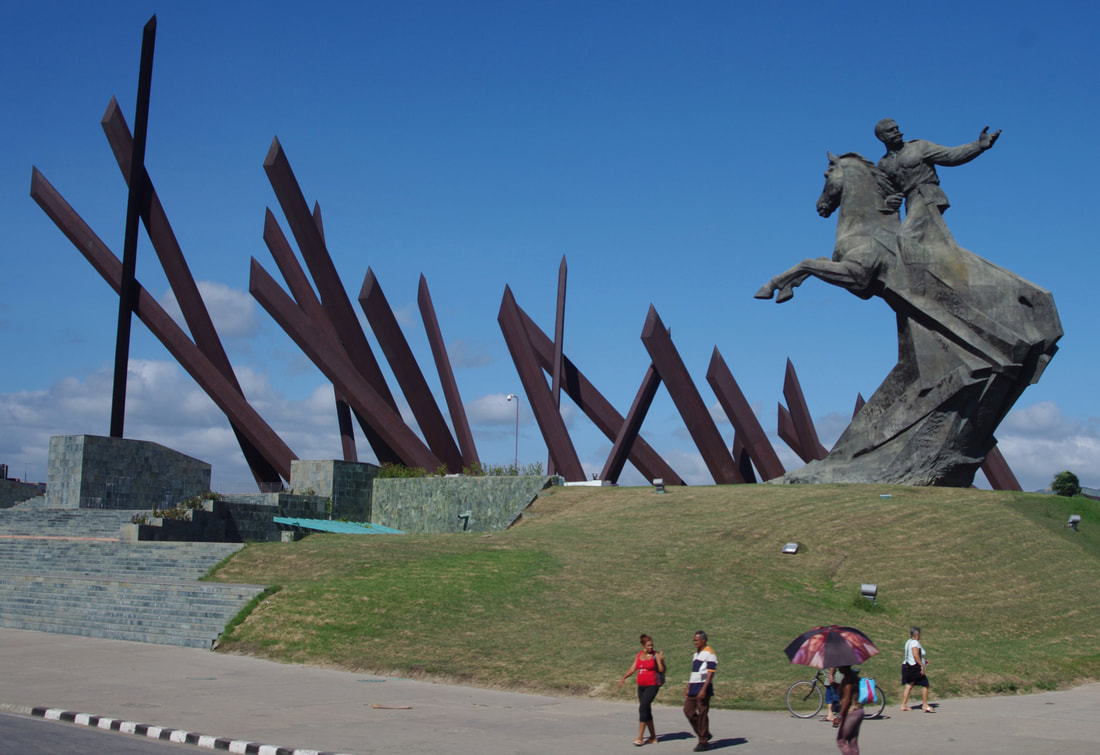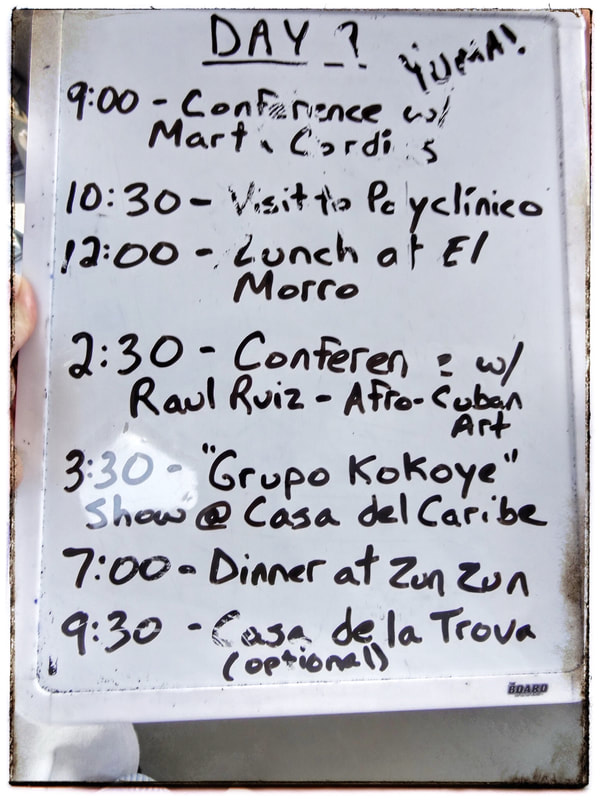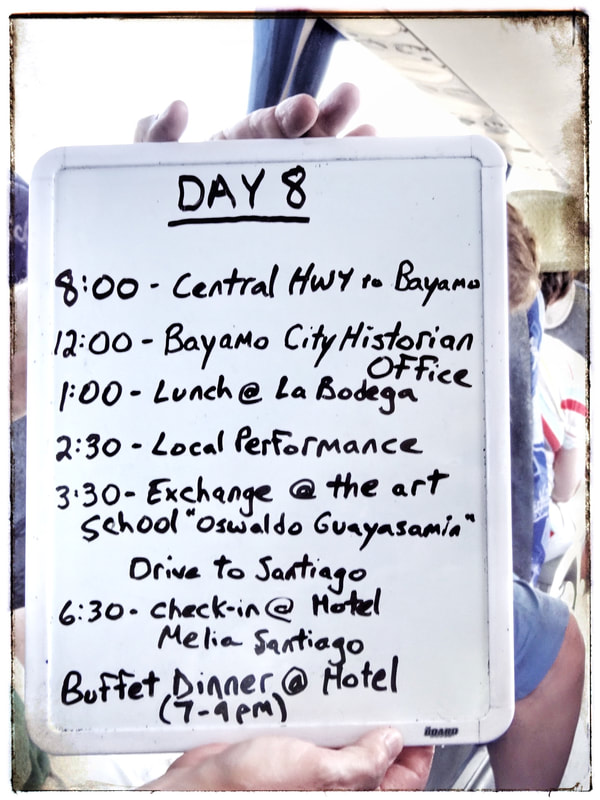Back in Santiago de Cuba, we are running late so change up the itinerary and head directly to Casa del Caribe (Caribbean Garden), a gorgeous old estate in a charming part of town that was transformed, in 1982, as a place to study Caribbean life. As such, it organizes two large festivals each year — Festival del Caribe and the Fiesta del Fuego — as well as concert nights, and Saturday night and Sunday afternoon dance performances.
We are here for a dance performance by the Kokoyé Folk Dance Company, which was established in 1989 by Juan Bautista Castillo Mustelier. His vision was to create an artistic dance company that would principally teach tourists about the origins of the Afro-Cuban culture through dance. Juan Bautista is considered a prestigious dancer known for his complex variations of the rumba, a choreographer, folklorist, and cultural tourism promoter. He is a member of the Association of Scenic Artists, the Union of Writers and Artists of Cuba, and has received personally, and on behalf of the company, many honors and awards. In addition to performing locally in Santiago de Cuba, Kokoyé has toured throughout Cuba and internationally in South- and Central-America. One of the dances I particularly enjoyed had to do with the lives of poor Caribbean women and their daily role as washer-women.
| A short drive away, we reach the home of artist, educator and national figure Alberto Lescay for a talk on his artwork. Best known for his large bronze installation across from our hotel in Santiago de Cuba's Revolution Square, "El Titan de Bronce," it celebrates the 19th century Cuban general Antonio Maceo Grajales. Lescay studied art at universities in Santiago and Havana as well as six-years spent further developing his art in St. Petersburg, Russia. |
Though one of the most successful contemporary artists in Cuba, his home/studio by design is modest and like a small museum filled with artworks by himself and other Cuban artists and artisans. He is an open and generous man, and very focused about his art, commitment to Cuban culture, and how he can help younger artists. Unlike other accomplished Cuban men we've met, he is very low-key. He holds Fidel Castro and Ché Guevara as folk heros and is clear that their legacies will be eternal. During the course of our conversation he points out that perhaps we've already noticed that throughout Cuba are many statues memorializing military heros (Maceo, de Cespedes, Ché) and revolutionary thinkers such as poet Jose Marti, however, there are no statues of Castro. He shares that this was by decree, which helps Castro maintain a public persona as a man of the people; not better or worse.
When Lescay won the commission to build the Maceo monument in Santiago de Cuba, it came with a substantial cash award. He declined the prize money, asking instead that the government fund a foundation — Foundacion Caguayo para Las Artes Monumentales y Aplicadas (Caguayo Foundation for Monumental and Applied Arts) — he had dreamed of creating to pass along skills he developed. When he began the project in the 1980s, there was only one artist who knew the techniques needed to create such vast quantities of bronze, and he was over 80 at the time. That's when Lescay realized that to create the Maceo monument, Cuba needed to create a school as many of the earlier generation of artists were dying off, and fewer young Cubans were being groomed to take their places. The monument took nine years and a team of almost 100 additional artists. They melted over 100 tons of bronze.
Additionally, Lescay creates bold abstract paintings, and helped establish and continues to support the Galeria Rene Valdes, a space for artists to exhibit works and interact as part of the city's vibrant cultural community.
When Lescay won the commission to build the Maceo monument in Santiago de Cuba, it came with a substantial cash award. He declined the prize money, asking instead that the government fund a foundation — Foundacion Caguayo para Las Artes Monumentales y Aplicadas (Caguayo Foundation for Monumental and Applied Arts) — he had dreamed of creating to pass along skills he developed. When he began the project in the 1980s, there was only one artist who knew the techniques needed to create such vast quantities of bronze, and he was over 80 at the time. That's when Lescay realized that to create the Maceo monument, Cuba needed to create a school as many of the earlier generation of artists were dying off, and fewer young Cubans were being groomed to take their places. The monument took nine years and a team of almost 100 additional artists. They melted over 100 tons of bronze.
Additionally, Lescay creates bold abstract paintings, and helped establish and continues to support the Galeria Rene Valdes, a space for artists to exhibit works and interact as part of the city's vibrant cultural community.
One more stop before heading to the Hotel Meliá Santiago is to a war memorial commemorating the 1898 victory known as the Spanish-American War. The monument acknowledges and celebrates the decisive support given to Cuba by the U.S. Army.
After returning to the Hotel Meliá Santiago for showers and a change of clothes, we meet others in the lobby for a cocktail before heading to dinner at Zunzun, a small restaurant located in a once private residence.
Not ready to call it a day, some of us join Phllippe at the Casa del la Trova for a night of dancing — well, some dancing, mostly watching! The trova or dance club is something out of Saturday Night Fever . . . just think Cuban-style. The men and women are dressed in their best and most alluring attire. I can only imagine what their lives must be during the day. As the band plays traditional Cuban Son music, couples flood the dance floor — its hard not to — and we are lucky to have front-row seats. Clearly there is both camaraderie as well as competitiveness as couples vie for center-attention. The men are strong and commanding in contrast to their partners who are agile and willowy as they are partnered around the floor at a dizzying speed. The energy is electrifying and the music is fabulous! Our guide Phillippe knows many of the best couples dancing, and with little encouragement, he shows off his stuff . . . impressive! All fantasies about my being a great rumba and salsa dancer are shattered in the first moments, but Cuban men are very forgiving! This was an incredibly fun and unforgettable night . . .



 RSS Feed
RSS Feed
